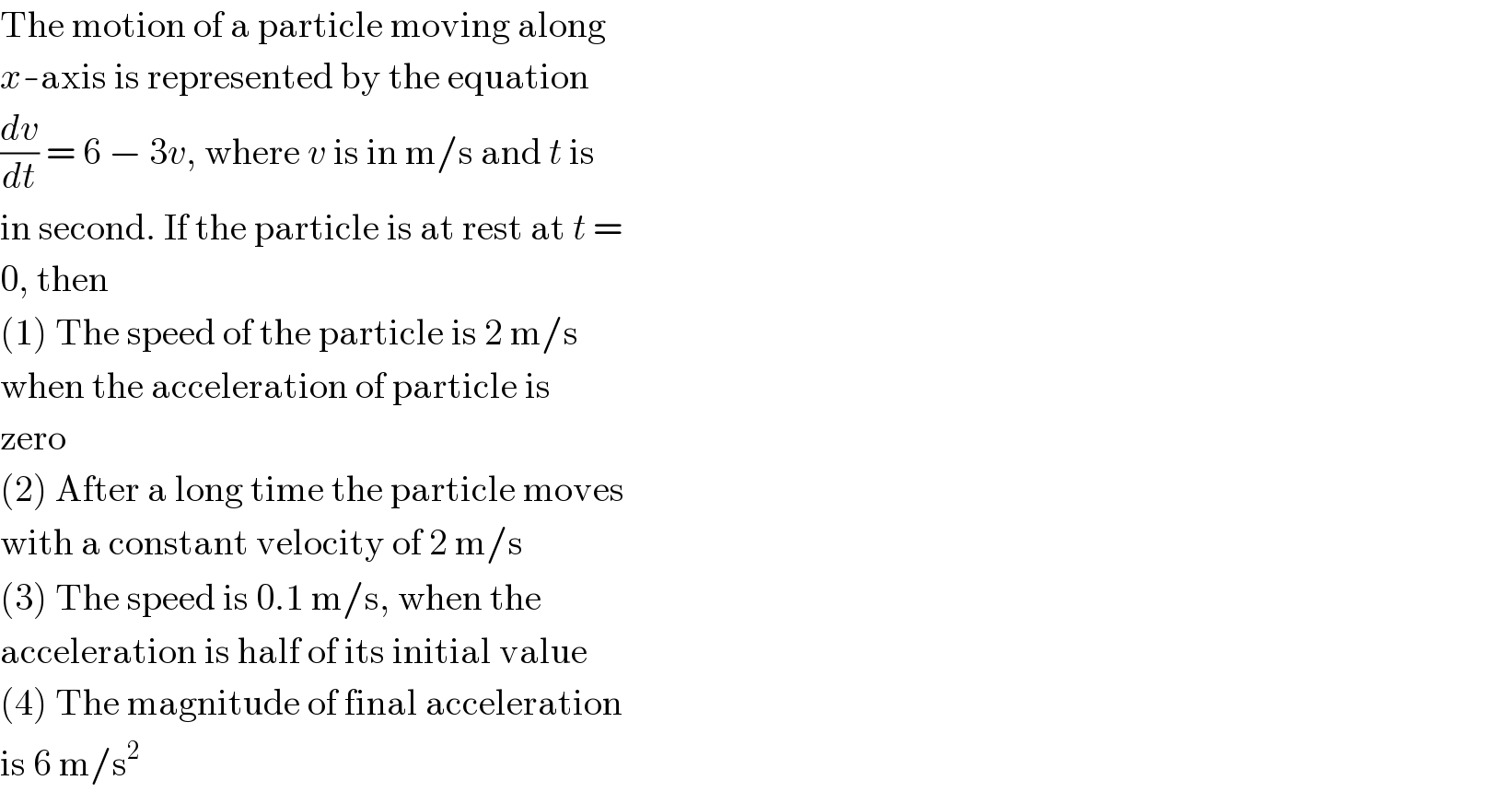
Question Number 15955 by Tinkutara last updated on 16/Jun/17

$$\mathrm{The}\:\mathrm{motion}\:\mathrm{of}\:\mathrm{a}\:\mathrm{particle}\:\mathrm{moving}\:\mathrm{along} \\ $$$${x}-\mathrm{axis}\:\mathrm{is}\:\mathrm{represented}\:\mathrm{by}\:\mathrm{the}\:\mathrm{equation} \\ $$$$\frac{{dv}}{{dt}}\:=\:\mathrm{6}\:−\:\mathrm{3}{v},\:\mathrm{where}\:{v}\:\mathrm{is}\:\mathrm{in}\:\mathrm{m}/\mathrm{s}\:\mathrm{and}\:{t}\:\mathrm{is} \\ $$$$\mathrm{in}\:\mathrm{second}.\:\mathrm{If}\:\mathrm{the}\:\mathrm{particle}\:\mathrm{is}\:\mathrm{at}\:\mathrm{rest}\:\mathrm{at}\:{t}\:= \\ $$$$\mathrm{0},\:\mathrm{then} \\ $$$$\left(\mathrm{1}\right)\:\mathrm{The}\:\mathrm{speed}\:\mathrm{of}\:\mathrm{the}\:\mathrm{particle}\:\mathrm{is}\:\mathrm{2}\:\mathrm{m}/\mathrm{s} \\ $$$$\mathrm{when}\:\mathrm{the}\:\mathrm{acceleration}\:\mathrm{of}\:\mathrm{particle}\:\mathrm{is} \\ $$$$\mathrm{zero} \\ $$$$\left(\mathrm{2}\right)\:\mathrm{After}\:\mathrm{a}\:\mathrm{long}\:\mathrm{time}\:\mathrm{the}\:\mathrm{particle}\:\mathrm{moves} \\ $$$$\mathrm{with}\:\mathrm{a}\:\mathrm{constant}\:\mathrm{velocity}\:\mathrm{of}\:\mathrm{2}\:\mathrm{m}/\mathrm{s} \\ $$$$\left(\mathrm{3}\right)\:\mathrm{The}\:\mathrm{speed}\:\mathrm{is}\:\mathrm{0}.\mathrm{1}\:\mathrm{m}/\mathrm{s},\:\mathrm{when}\:\mathrm{the} \\ $$$$\mathrm{acceleration}\:\mathrm{is}\:\mathrm{half}\:\mathrm{of}\:\mathrm{its}\:\mathrm{initial}\:\mathrm{value} \\ $$$$\left(\mathrm{4}\right)\:\mathrm{The}\:\mathrm{magnitude}\:\mathrm{of}\:\mathrm{final}\:\mathrm{acceleration} \\ $$$$\mathrm{is}\:\mathrm{6}\:\mathrm{m}/\mathrm{s}^{\mathrm{2}} \\ $$
Commented by prakash jain last updated on 16/Jun/17

$$\int\frac{{dv}}{\mathrm{6}−\mathrm{3}{v}}=\int{dt} \\ $$$$−\frac{\mathrm{1}}{\mathrm{3}}\mathrm{ln}\:\left(\mathrm{6}−\mathrm{3}{v}\right)={t}+{C} \\ $$$${t}=\mathrm{0},{v}=\mathrm{0} \\ $$$$−\frac{\mathrm{1}}{\mathrm{3}}\mathrm{ln}\:\mathrm{6}={C} \\ $$$$\frac{\mathrm{1}}{\mathrm{3}}\mathrm{ln}\:\frac{\mathrm{6}−\mathrm{3}{v}}{\mathrm{6}}=−{t} \\ $$$$\frac{\mathrm{6}−\mathrm{3}{v}}{\mathrm{6}}={e}^{−\mathrm{3}{t}} \Rightarrow{v}=\mathrm{2}\left(\mathrm{1}−\mathrm{3}{e}^{−{t}} \right)\:\:\:...\left({A}\right) \\ $$$${a}=\mathrm{0}\Rightarrow\frac{{dv}}{{dt}}=\mathrm{0}\Rightarrow\mathrm{6}−\mathrm{3}{v}=\mathrm{0}\Rightarrow{v}=\mathrm{2} \\ $$$${t}\rightarrow\infty,{e}^{−\mathrm{3}{t}} \rightarrow\mathrm{0}\Rightarrow{v}=\mathrm{2}\:\left({from}\:{A}\right) \\ $$$${t}\rightarrow\infty,{v}\rightarrow{z}\mathrm{2},\frac{{dv}}{{dt}}\rightarrow\mathrm{0} \\ $$$${t}=\mathrm{0},{v}=\mathrm{0}\Rightarrow{a}_{\mathrm{0}} =\mathrm{6}−\mathrm{3}{v}=\mathrm{6} \\ $$$${a}_{{t}} =\mathrm{3}\Rightarrow{v}=\mathrm{1} \\ $$
Commented by Tinkutara last updated on 16/Jun/17

$$\mathrm{Thanks}\:\mathrm{Sir}! \\ $$
